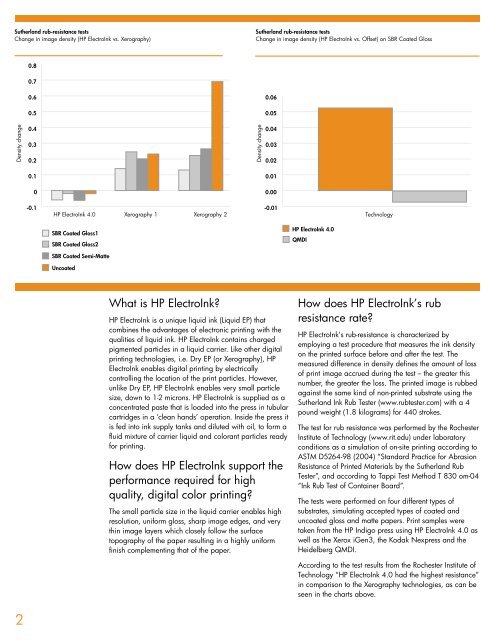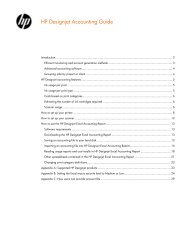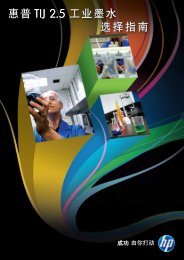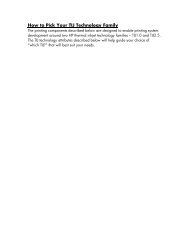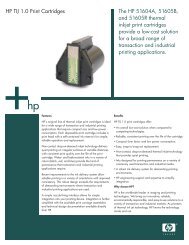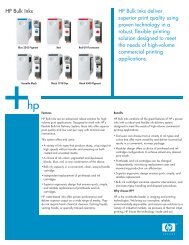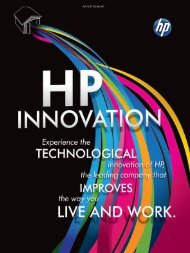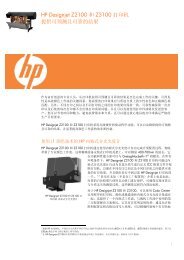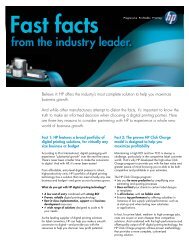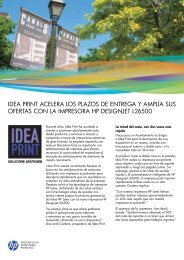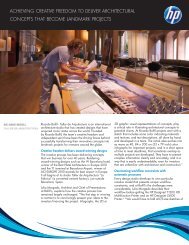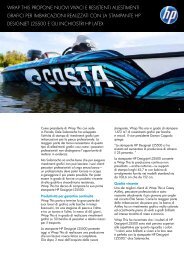HP ElectroInk Frequently Asked Questions - Hewlett Packard
HP ElectroInk Frequently Asked Questions - Hewlett Packard
HP ElectroInk Frequently Asked Questions - Hewlett Packard
Create successful ePaper yourself
Turn your PDF publications into a flip-book with our unique Google optimized e-Paper software.
Sutherland rub-resistance tests<br />
Change in image density (<strong>HP</strong> <strong>ElectroInk</strong> vs. Xerography)<br />
Density change<br />
2<br />
0.8<br />
0.7<br />
0.6<br />
0.5<br />
0.4<br />
0.3<br />
0.2<br />
0.1<br />
0<br />
-0.1<br />
<strong>HP</strong> <strong>ElectroInk</strong> 4.0 Xerography 1 Xerography 2<br />
SBR Coated Gloss1<br />
SBR Coated Gloss2<br />
SBR Coated Semi-Matte<br />
Uncoated<br />
What is <strong>HP</strong> <strong>ElectroInk</strong>?<br />
<strong>HP</strong> <strong>ElectroInk</strong> is a unique liquid ink (Liquid EP) that<br />
combines the advantages of electronic printing with the<br />
qualities of liquid ink. <strong>HP</strong> <strong>ElectroInk</strong> contains charged<br />
pigmented particles in a liquid carrier. Like other digital<br />
printing technologies, i.e. Dry EP (or Xerography), <strong>HP</strong><br />
<strong>ElectroInk</strong> enables digital printing by electrically<br />
controlling the location of the print particles. However,<br />
unlike Dry EP, <strong>HP</strong> <strong>ElectroInk</strong> enables very small particle<br />
size, down to 1-2 microns. <strong>HP</strong> <strong>ElectroInk</strong> is supplied as a<br />
concentrated paste that is loaded into the press in tubular<br />
cartridges in a ‘clean hands’ operation. Inside the press it<br />
is fed into ink supply tanks and diluted with oil, to form a<br />
fluid mixture of carrier liquid and colorant particles ready<br />
for printing.<br />
How does <strong>HP</strong> <strong>ElectroInk</strong> support the<br />
performance required for high<br />
quality, digital color printing?<br />
The small particle size in the liquid carrier enables high<br />
resolution, uniform gloss, sharp image edges, and very<br />
thin image layers which closely follow the surface<br />
topography of the paper resulting in a highly uniform<br />
finish complementing that of the paper.<br />
Sutherland rub-resistance tests<br />
Change in image density (<strong>HP</strong> <strong>ElectroInk</strong> vs. Offset) on SBR Coated Gloss<br />
Density change<br />
0.06<br />
0.05<br />
0.04<br />
0.03<br />
0.02<br />
0.01<br />
0.00<br />
-0.01<br />
<strong>HP</strong> <strong>ElectroInk</strong> 4.0<br />
QMDI<br />
Technology<br />
How does <strong>HP</strong> <strong>ElectroInk</strong>’s rub<br />
resistance rate?<br />
<strong>HP</strong> <strong>ElectroInk</strong>’s rub-resistance is characterized by<br />
employing a test procedure that measures the ink density<br />
on the printed surface before and after the test. The<br />
measured difference in density defines the amount of loss<br />
of print image accrued during the test – the greater this<br />
number, the greater the loss. The printed image is rubbed<br />
against the same kind of non-printed substrate using the<br />
Sutherland Ink Rub Tester (www.rubtester.com) with a 4<br />
pound weight (1.8 kilograms) for 440 strokes.<br />
The test for rub resistance was performed by the Rochester<br />
Institute of Technology (www.rit.edu) under laboratory<br />
conditions as a simulation of on-site printing according to<br />
ASTM D5264-98 (2004) “Standard Practice for Abrasion<br />
Resistance of Printed Materials by the Sutherland Rub<br />
Tester”, and according to Tappi Test Method T 830 om-04<br />
“Ink Rub Test of Container Board”.<br />
The tests were performed on four different types of<br />
substrates, simulating accepted types of coated and<br />
uncoated gloss and matte papers. Print samples were<br />
taken from the <strong>HP</strong> Indigo press using <strong>HP</strong> <strong>ElectroInk</strong> 4.0 as<br />
well as the Xerox iGen3, the Kodak Nexpress and the<br />
Heidelberg QMDI.<br />
According to the test results from the Rochester Institute of<br />
Technology “<strong>HP</strong> <strong>ElectroInk</strong> 4.0 had the highest resistance”<br />
in comparison to the Xerography technologies, as can be<br />
seen in the charts above.


